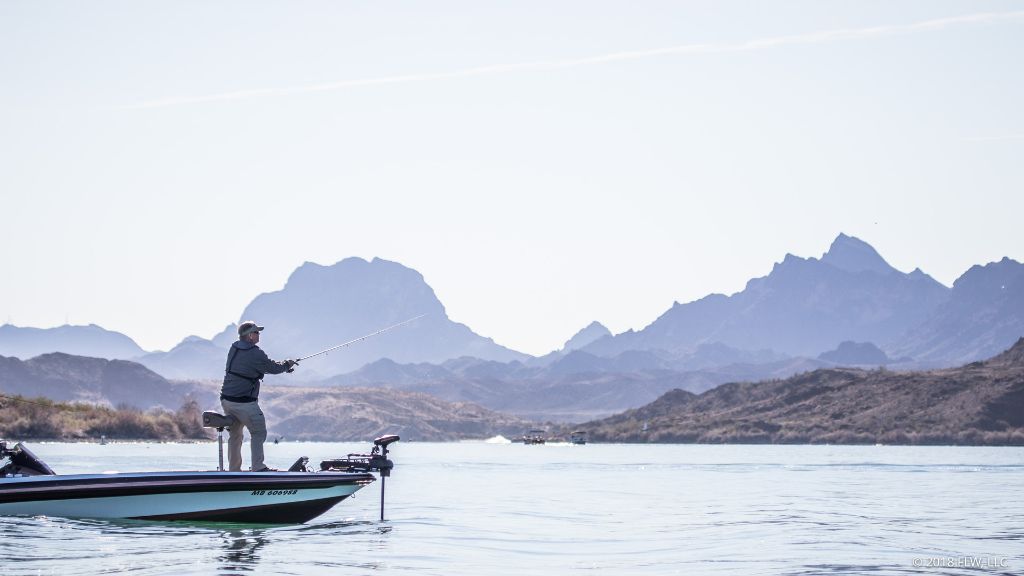Red-Hot Spawn Bite Expected at Havasu
Western Division opener perfectly timed for a slugfest

Spawning bass and spring break will be the story lines at the Toyota Series Western Division opener at Lake Havasu in mid-March.
Well, OK … the spawning bass will certainly be the main focus of the anglers. But dealing with traffic from pleasure boaters will definitely contribute to the pros’ decision-making, particularly on the weekend.
Regardless of the extra boat wake, this should be an all-out slugfest of a tournament, where bass will be caught in all stages of the spawn, and targeting a mix of largemouths and smallmouths will likely be necessary for a shot at winning.
Tournament details
Toyota Series Western Division
Lake Havasu City, Ariz.
March 12-14, 2020
Hosted by Lake Havasu City Convention & Visitors Bureau
How the fishery sets up
Situated on the border between California and Arizona, Lake Havasu is a desert reservoir that’s home to healthy populations of both largemouth and smallmouth bass. According to local pro Joe Uribe Jr., the fishery is healthy, and there are gobs of bass to be caught. He would know, too. Uribe has four top-10 finishes, including two wins, in Toyota Series events on Lake Havasu. He also finished second in the 2020 WON Bass Arizona Open on Havasu in early February.
Havasu is an oasis of sorts where tourists flock to enjoy watersports and other outdoor pursuits, in addition to fishing. And in spring, it’ll be a busy spot.
Fish cribs, or man-made fish-attracting cover, are common fishing targets during the prespawn. There are also natural points and rocky structure throughout the lake, plus tules and brush in shallow tributaries.
What to expect
Typically, FLW visits Lake Havasu in early February, but this season’s mid-March timing presents new conditions. For starters, it falls on spring break, and Uribe expects boat traffic to be heavy. He says running up the river can get a little dicey due to boat wake, resulting in longer run times than normal during peak boating hours.
It also puts the tournament right on top of the spawn.
“Typically, when we’re there in early February, the fish are still in their winter patterns,” says Uribe. “They really haven’t moved up yet. Water levels are usually low because they draw the water down a little bit. Low water at Havasu is about 3 feet [down].
“In March, we’ve got another full moon coming up [March 9], and it’s going to be full-blown spawn. The first wave is already up now [the first couple days of March]. So by the time we’re there, I imagine the next wave is going to come up. The smallmouth were up even a couple weeks ago when the water was in the upper 50s. Now the water temperature is already in the low 60s, and the first wave of largemouth are up. I imagine fishing is going to be really good.”
The extended forecast looks great as well with lows in the upper 50s and highs in the low 80s during tournament week. Wind or boat wake might make sight-fishing difficult in unprotected waters, but most likely it won’t be too challenging to put a limit in the livewell.
Uribe, in strategizing for another win, has set his goal at 18 to 20 pounds per day. He predicts the cut will fall on about 16 pounds per day and expects a traffic jam of pros in the 13- to 14-pound range. He also wouldn’t be surprised to see a limit or two in the neighborhood of 25 pounds.
The species breakdown will be interesting to see given the timing.
“The smallmouth are so predominant as far as that 3- to 4-pound class now, but definitely are becoming a big player,” Uribe adds. “To win that tournament, you’re going to have to have a couple big largemouth, and when I’m talking big largemouth I mean 6-plus. You win it with largemouth. The smallmouth are, I think, more accessible. The largemouth are going to be a little harder to find.”
Baits and techniques
Finesse is popular on Havasu due to its clear water. Still, there are other factors in play.
“To do well in this event you’re going to have to mark several good, quality largemouth on beds and catch some smallmouth,” says Uribe. “If it gets windy, that’s going to make it difficult to sight-fish. Guys can traditionally fish with jigs and drop-shots. Reaction baits can definitely always catch them if the wind permits it. If it’s flat calm, pretty much finesse baits are going to dominate.”
Much of the better largemouth fishing this time of year takes place up the river or in the back of shallow tributaries. Tules and brush provide the fish with cover in which to hide. Getting them out will take some heavy-cover tactics.
Most of the smallmouth fishing will go down on main-lake points, rocky habitat, shallow reefs and beach areas.
Where and how the top pros catch them, we’ll have to wait and see. For now, we know we can expect gorgeous weather and a lot of fish catches when the Western Division gets rolling.